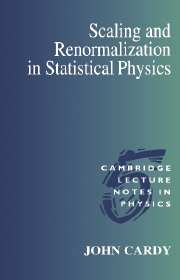Book contents
- Frontmatter
- Dedication
- Contents
- Preface
- 1 Phase transitions in simple Systems
- 2 Mean field theory
- 3 The renormalization group idea
- 4 Phase diagrams and fixed points
- 5 The perturbative renormalization group
- 6 Low dimensional Systems
- 7 Surface critical behaviour
- 8 Random Systems
- 9 Polymer statistics
- 10 Critical dynamics
- 11 Conformal symmetry
- Appendix: Gaussian Integration
- Selected Bibliography
- Index
11 - Conformal symmetry
Published online by Cambridge University Press: 05 February 2015
- Frontmatter
- Dedication
- Contents
- Preface
- 1 Phase transitions in simple Systems
- 2 Mean field theory
- 3 The renormalization group idea
- 4 Phase diagrams and fixed points
- 5 The perturbative renormalization group
- 6 Low dimensional Systems
- 7 Surface critical behaviour
- 8 Random Systems
- 9 Polymer statistics
- 10 Critical dynamics
- 11 Conformal symmetry
- Appendix: Gaussian Integration
- Selected Bibliography
- Index
Summary
We saw in Chapter 3 that the hamiltonian for a System at a critical point flows under the renormalization group into a critical fixed point. Under a renormalization group transformation, the microscopic length scale is rescaled by a constant factor b, and so the coordinates of a given point, as measured in units of this length scale, transform according to r → b−1r. This is called a scale transformation. Once the flows reach such a fixed point, the parameters of the hamiltonian no longer change, and it is said to be scale invariant. As well as being scale invariant, the fixed point hamiltonian usually possesses other spatial symmetries. For example, if the underlying model is defined on a lattice, so that its hamiltonian is invariant under lattice translations, the corresponding critical fixed point hamiltonian is generally invariant under arbitrary uniform translations. This is because terms which might be added to the hamiltonian which break the symmetry under continuous translations down to its subgroup of lattice translations are irrelevant at such a fixed point. Similarly, if the lattice model is invariant under a sufficiently large subgroup of the rotation group (for example, if the interactions in the x and y directions on a Square lattice are equal), then the fixed point hamiltonian enjoys full rotational invariance. As discussed on p.58, even if the interactions are anisotropic, rotational invariance may often be recovered by a suitable finite relative rescaling of the coordinates.
Information
- Type
- Chapter
- Information
- Scaling and Renormalization in Statistical Physics , pp. 206 - 226Publisher: Cambridge University PressPrint publication year: 1996
